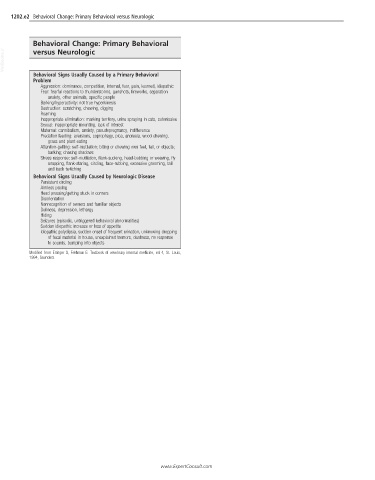Page 2429 - Cote clinical veterinary advisor dogs and cats 4th
P. 2429
1202.e2 Behavioral Change: Primary Behavioral versus Neurologic
Behavioral Change: Primary Behavioral
VetBooks.ir versus Neurologic
Behavioral Signs Usually Caused by a Primary Behavioral
Problem
Aggression: dominance, competition, internal, fear, pain, learned, idiopathic
Fear: fearful reactions to thunderstorms, gunshots, fireworks, separation
anxiety, other animals, specific people
Barking/hyperactivity: not true hyperkinesis
Destruction: scratching, chewing, digging
Roaming
Inappropriate elimination: marking territory, urine spraying in cats, submissive
Sexual: inappropriate mounting, lack of interest
Maternal: cannibalism, anxiety, pseudopregnancy, indifference
Predation feeding: aversions, coprophagy, pica, anorexia, wood chewing,
grass and plant eating
Attention-getting: self-mutilation; biting or chewing own feet, tail, or objects;
barking; chasing shadows
Stress response: self-mutilation, flank-sucking, head-bobbing or weaving, fly
snapping, flank-staring, circling, face-rubbing, excessive grooming, tail
and back twitching
Behavioral Signs Usually Caused by Neurologic Disease
Persistent circling
Aimless pacing
Head pressing/getting stuck in corners
Disorientation
Nonrecognition of owners and familiar objects
Dullness, depression, lethargy
Hiding
Seizures (episodic, untriggered behavioral abnormalities)
Sudden idiopathic increase or loss of appetite
Idiopathic polydipsia, sudden onset of frequent urination, unknowing dropping
of fecal material in house, unexplained tremors, deafness, no response
to sounds, bumping into objects
Modified from Ettinger S, Feldman E: Textbook of veterinary internal medicine, ed 4, St. Louis,
1994, Saunders.
www.ExpertConsult.com

